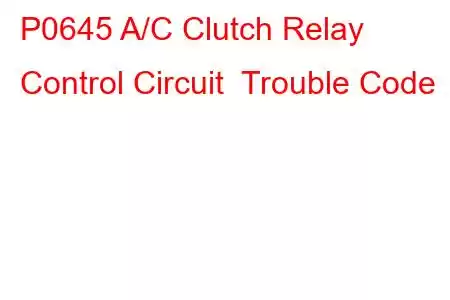P0645 A/C Clutch Relay Control Circuit
OBD-II Trouble Code Technical Description
A/C Clutch Relay Control Circuit
What does that mean?
This is a generic diagnostic trouble code (DTC) and applies to many OBD-II vehicles (1996-newer). That may include but is not limited to vehicles from GM, Chrysler, Chevrolet, Dodge, Jeep, Cadillac, Ford, Ram, etc. Although generic, the exact repair steps may vary depending on year, make, model and powertrain configuration.
The P0645 OBD-II trouble code is associated with the air conditioning (A/C) clutch relay control circuit. When the Powertrain Control Module (PCM) or one of the other supporting control modules has detected improper signals within the A/C clutch relay control electrical circuit, code P0645 will be set. Based on the vehicle and the specific malfunction this code may be set as many as eight times before the check engine light is illuminated.
The purpose of the A/C clutch relay control circuit is to control the operation of the air conditioning. This is accomplished by providing power to the A/C clutch to engage the A/C compressor. Based on the specific vehicle, this circuit can be very complex and include several control modules.
Code P0645 is set by the PCM when it detects a general malfunction in the air conditioning relay control circuit.
What is the severity of this DTC?
The severity of this code can vary from just an illuminated check engine light with the air conditioning working fine to it running poorly or not at all.
What are some of the symptoms of the code?
Symptoms of a P0645 trouble code may include:
A/C functioning poorly A/C not working at all Check engine light illuminatedWhat are some of the common causes of the code?
Causes for this P0645 code may include:
Faulty A/C clutch relay Defective A/C clutch Broken control module ground strap Defective control module Blown fuse or fuse-able link (if applicable) Corroded or damaged connector Low or over serviced A/C system Faulty or damaged wiring Faulty A/C Compressor Faulty PCMWhat are some P0645 troubleshooting steps?
The first step in the troubleshooting process for any malfunction is to research the Technical Service Bulletins (TSB's) for the specific vehicle by year, model and power plant. In some circumstances this can save a lot of time in the long run by pointing you in the right direction.
The second step is a thorough visual inspection to check the associated wiring for obvious defects such as scraping, rubbing, bare wires, or burn spots. Next is to check the connectors and connections for security, corrosion and damaged pins. This process must include all wiring connectors and connections to components including control modules and ground straps. This circuit can be very complex and include several relays, fuse-able links and fuses in some circumstances.
Advanced Steps
The advanced steps become very vehicle specific and require the appropriate advanced equipment to perform accurately. These procedures require a digital multi meter and the specific technical references for the vehicle. Voltage requirements will very based on the specific year and model of the vehicle.
Voltage Checks
The voltage check process for this circuit requires troubleshooting guidelines that are specific and in the proper sequence. The optional equipment on the automobile involved will determine the troubleshooting requirements. More options and equipment effect the number of control modules involved in the troubleshooting process. Please reference the list of possible supporting control modules listed above.
If this process identifies the absence of a power source or ground, continuity testing may be required to check the integrity of the wiring, control modules and other components. All of the control module ground straps may need to be includ
Read: 44


